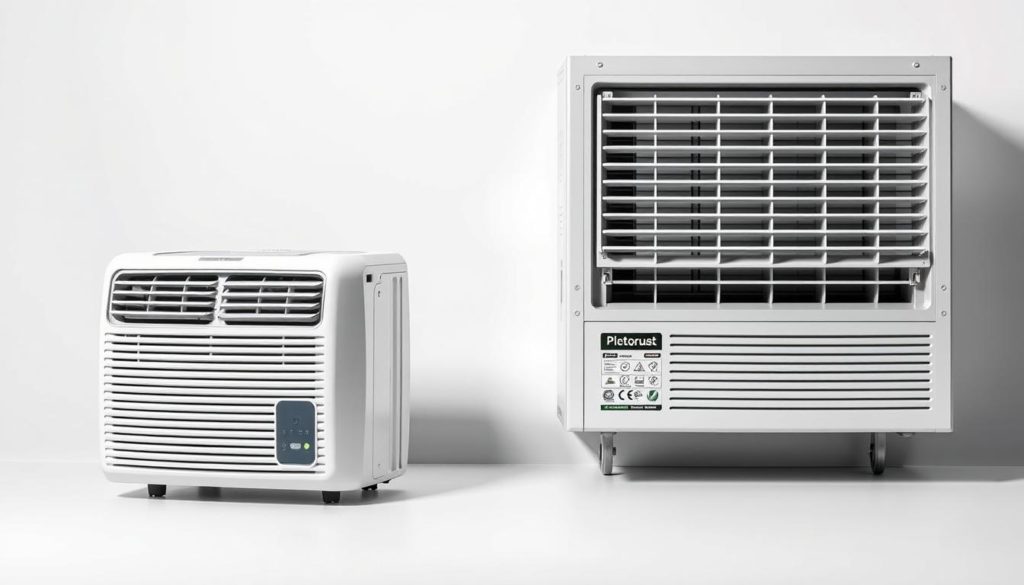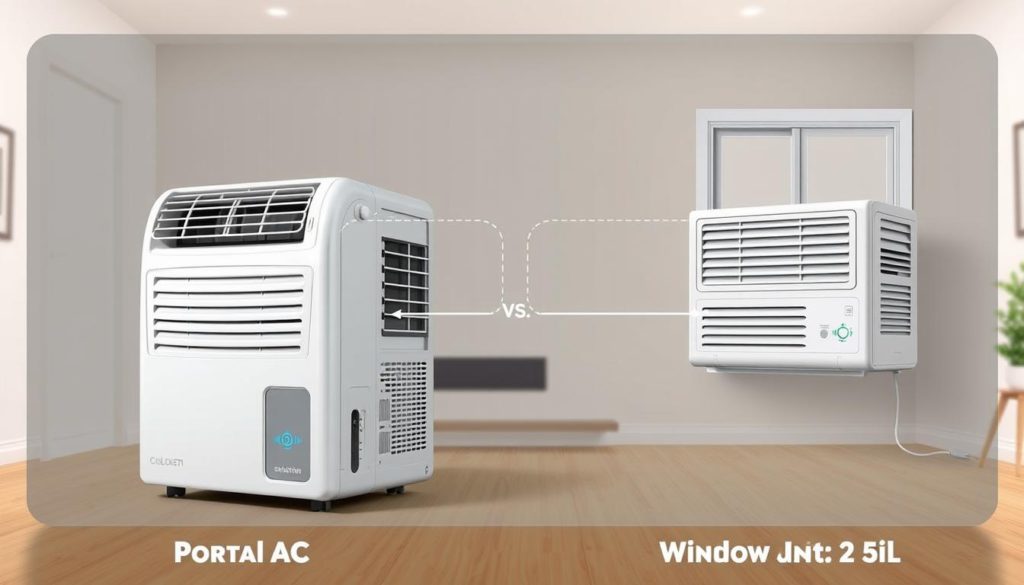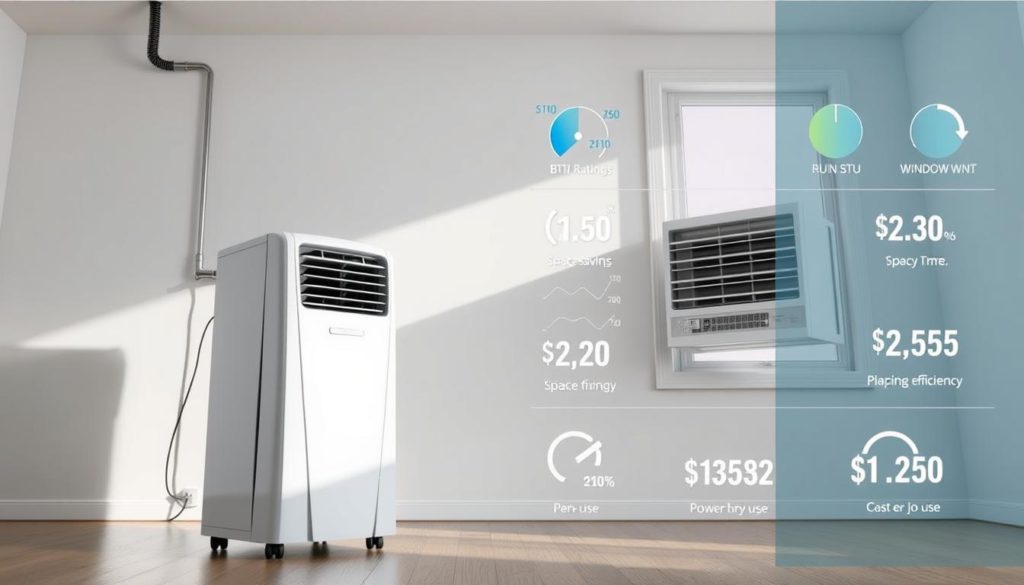Summer heat doesn’t just test your patience—it tests your wallet. Choosing between cooling systems isn’t about brands or trends. It’s about energy bills, space limitations, and how much sweat you’re willing to shed during setup. Let’s cut through the noise.
Window air conditioners anchor themselves like silent sentinels, while portable models roll wherever you need relief. But which one truly fits your life? We analyzed installation headaches, long-term costs, and real-world performance using data from industry leaders and consumer reports.
This isn’t a surface-level chat. You’ll get specific numbers on noise levels (measured in decibels), efficiency ratings, and even how much floor space each option steals. Whether you rent an apartment or own a home, the right choice could save hundreds annually.
Key Takeaways
- Window units typically use 10-15% less energy than portable models
- Installation time varies from 30 minutes (portable) to 2 hours (window)
- Portable air conditioners require 18-24 inches of clearance space
- Average noise difference: 52 dB (window) vs 58 dB (portable)
- Energy Star-rated models reduce annual costs by $70-$120
Understanding the Basics of Air Conditioning Options

Effective climate control hinges on choosing between mobility and permanence. Two distinct cooling systems dominate residential spaces: mobile models that follow you and fixed systems that stay put. Let’s break down their core designs before exploring technical specifics.
Design and Functionality Differences
Mobile cooling devices operate through a single hose or dual-vent setup. They pull warm air from your room, chill it using refrigerant, then expel heat through a window adapter. These self-contained units work best in spaces under 500 square feet, like studios or home offices.
Fixed systems mount directly into window frames. Their design seals gaps better, preventing cooled air from escaping. Most handle larger areas—up to 800 square feet—while using 10-15% less energy than their movable counterparts according to ENERGY STAR® data.
Mechanics and Home Integration
Refrigerant cycles drive both systems, but installation varies drastically. Mobile units need minimal setup—just a power outlet and temporary venting. Permanent models require secure mounting brackets and weather stripping to optimize efficiency.
Consider your home’s layout. Fixed conditioners free up floor space but block window access. Mobile versions let you shift cooling power between rooms but occupy 2-3 square feet of living area. Your choice impacts both comfort and utility bills long-term.
Portable AC vs Window Unit: Which is Better for You?

Every square foot and decibel counts when balancing cost and comfort in your space. Let’s dissect critical differences through real-world metrics that impact your wallet and daily life.
Side-by-Side Comparison of Key Features
| Feature | Mobile Systems | Fixed Models |
|---|---|---|
| Price Range | $200-$800 | $150-$600 |
| BTU Capacity | 8,000-14,000 | 5,000-24,500 |
| Setup Time | 15-30 minutes | 1-2 hours |
| Noise Level | 58 dB average | 52 dB average |
Mobile systems demand 10-15% more energy than fixed units according to 2023 utility reports. Their single-hose exhaust design leaks cooled air, forcing compressors to work harder. Fixed models vent heat directly outside through sealed frames.
Consider physical demands before buying. Window installations require lifting 60-100 pounds and securing brackets—challenging for renters or people in upper-floor apartments. Mobile versions simply need a power outlet and temporary venting kit.
For rooms under 400 sq ft, both options perform well. Larger spaces? Prioritize fixed systems with higher BTU ratings. One Chicago renter reported: “My 12,000 BTU window unit cools my entire loft faster than two portable machines ever did.”
Installation, Space, and Energy Efficiency Considerations

Your cooling choice reshapes rooms and budgets. Mobile systems promise plug-and-play convenience, while fixed models demand upfront effort for lasting rewards. Let’s map out what each option demands from your time and living area.
Setup Speed vs. Long-Term Gains
Rolling units need three steps: position near a window, attach the vent hose, and plug in. No tools required. But every room change means redoing the exhaust setup—a 10-minute task that adds up over summer.
Fixed systems require muscle. Mounting brackets and weather stripping take 1-2 hours initially. Once installed, they stay put. A Boston landlord notes: “Tenants prefer window models—no tripping over hoses, and bedrooms stay clutter-free.”
Space and Power Trade-Offs
| Factor | Mobile Cooling | Fixed Cooling |
|---|---|---|
| Floor Space Used | 2.5-3.5 sq ft | 0 sq ft |
| Annual Energy Cost | $145-$220 | $120-$180 |
| Ideal Room Size | Up to 400 sq ft | Up to 800 sq ft |
Fixed models win for energy efficiency, using 8-12% less power according to 2023 EPA data. Their sealed design prevents cooled air leaks. Mobile units lose efficiency when moved—each relocation breaks the window seal temporarily.
Small apartments face tough choices. A 300 sq ft studio might use a mobile system for easy setup. But a 500 sq ft living area? Fixed cooling saves $40/year and keeps walkways clear. Your physical ability matters too—lifting 80-pound window units isn’t for everyone.
Comparing Noise, Portability, and Operational Costs
Cooling systems shape your daily comfort through soundscapes and energy bills. While some systems hum like background noise, others disrupt movie nights or video calls. Let’s explore how decibel levels and mobility affect your rooms.
Decibel Differences and Room Dynamics
Fixed models direct compressor noise outdoors through window seals. Mobile systems keep all mechanics inside, creating a 58 dB average—similar to dishwasher volume. Bedrooms and offices often need quieter options below 55 dB.
| Factor | Mobile Systems | Fixed Models |
|---|---|---|
| Noise Level | 55-60 dB | 48-54 dB |
| Energy Cost/Year | $160-$240 | $130-$190 |
| Relocation Time | 10-15 minutes | Not movable |
Portability demands trade-offs. Moving a system between rooms breaks window seals temporarily, leaking cooled heat. Each relocation adds 10-15 minutes of setup time—frustrating during heatwaves.
Energy bills reveal another gap. Mobile options use 12-18% more power annually due to single-hose designs. Fixed models maintain efficiency by sealing cold air in.
- Check product specs for “sleep mode” features (below 50 dB)
- Add acoustic panels near louder systems
- Match BTU ratings to room size for optimal sound-to-power ratios
Your floor plan decides the winner. Open layouts suit fixed cooling, while separated rooms might need movable systems. As one HVAC technician notes: “Quiet operation often means sacrificing flexibility—know your non-negotiables.”
Conclusion
Choosing the right cooling solution transforms how you live through sweltering seasons. Your decision hinges on three factors: available square footage, installation constraints, and long-term energy expenses. Compact spaces under 400 square feet benefit from movable systems, while larger areas demand fixed units with higher BTU ratings.
Fixed models save floor space by mounting in windows but require permanent setup. Mobile options offer room-to-room flexibility at the cost of 2-3 square feet of living area. Energy-efficient designs slash annual bills by 12-18%, making them smarter for year-round use.
Consider your home’s layout and cooling needs carefully. Renters or multi-room homes might prioritize portability, while those seeking quiet operation and lower decibel levels should opt for window installations. Always match the system’s capacity to your room’s dimensions for peak performance.
Your ideal pick balances immediate comfort with future savings. Review the data on noise levels, BTU requirements, and setup complexity provided earlier. A well-informed choice keeps your space chill without burning through your budget.
FAQ
Which cooling option is easier to install?
Window air conditioners require mounting in a window frame with a bracket and seal. Portable models need minimal setup—just place them near a window, attach the exhaust hose, and plug them in. However, they may not fit all window types.
Do portable units use more energy than window systems?
Portable air conditioners often consume 10–20% more energy than window units for the same cooling capacity. Their design forces them to expel hot air through a hose, which can reduce efficiency. Look for ENERGY STAR® ratings to compare energy use.
Can a portable model cool a large room as effectively as a window unit?
Window systems generally offer stronger airflow and higher BTU ratings, making them better for larger spaces. Portable devices work best in rooms under 500 square feet. Always check the BTU-to-room-size ratio before buying.
How do noise levels compare between the two types?
Window air conditioners tend to operate more quietly since their compressors sit outside. Portable devices have internal compressors, leading to noise levels around 50–60 decibels. For quiet operation, check decibel ratings in product specs.
Which option saves more floor space?
Window units don’t take up floor space, making them ideal for small rooms. Portable models require floor area and clearance around the exhaust hose. If space is limited, a window system might be a better fit.
Are portable air conditioners truly "portable"?
While they have wheels for moving between rooms, you’ll still need a nearby window and outlet. Draining condensation regularly adds maintenance. Window units stay fixed once installed but provide consistent cooling.
Which type lasts longer?
Window air conditioners typically have longer lifespans (8–10 years) due to durable outdoor components. Portable units average 5–7 years because their internal parts work harder. Proper maintenance can extend both systems’ longevity.
